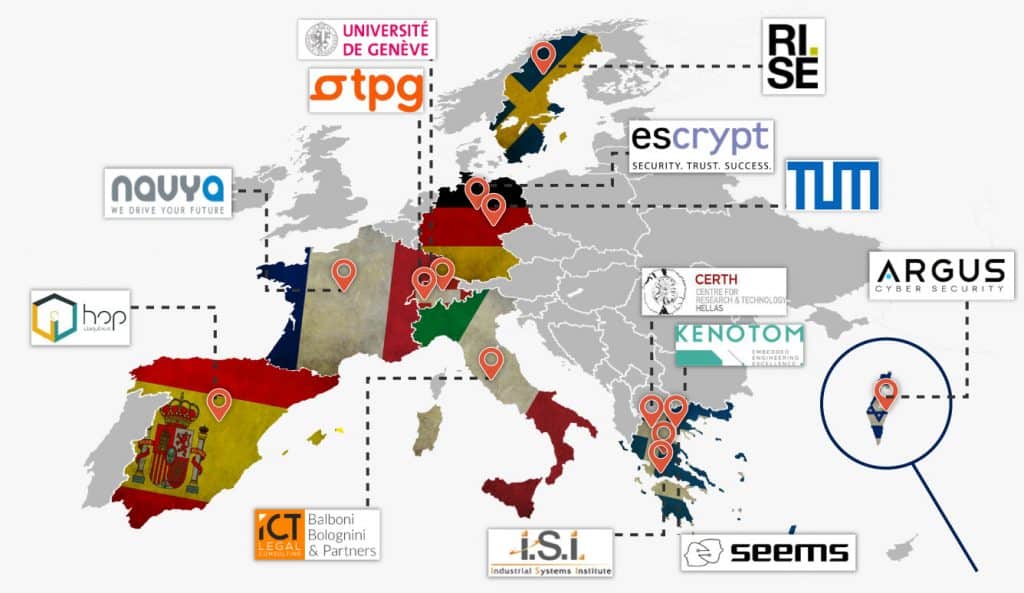NIoVe aims to detect cyber-attacks in realtime while simultaneously preventing them
What is nIoVe?
nIoVe is a European project that has received funding from the European Union´s Horizon 2020 research and innovation Programme under grant agreement No 833742. This project is composed of twelve competitive organisations across Europe specialised in different fields such as Industry, Cybersecurity, IoT, Commercialization and software development, to name but a few:
- CERTH is a leading Greek European Research in the sector of risk management
- UniGe is a top European Switzerland Research centre focused on data analytics and detection techniques, (significant) data handling and visualisation.
- RISE is a top European Swedish Research Center with higher expertise in cybersecurity, machine learning, sensors and actuators, communication networks and data analytics to visualisation, interaction design and service development.
- TUM is part of a German university at the top level of blockchain verification, cyber-physical system architectures, security of Internet of Things (IoT).
- ATHINA is formed by professionals with higher expertise in Industrial Information and Communication Systems, Embedded Systems, Security, Modelling and Automation of Industrial Systems.
- NAVYA is a French organisation focus on vehicles manufacturer and provider, fleets of buses.
- KENOTOM is a Greek company focus on ECUs integration.
- TPG is a Public Transport Authority located in Switzerland centred on the charge of all aspects of public mobility in Geneva.
- ICTL is a legal consulting located in Italy with higher expertise on regulation compliance and certification for CAVs and autonomous vehicles manufacturers and suppliers.
- SEEMS is an innovative Greek SME centred on the Internet of Things solutions, employing artificial intelligence and machine learning technologies.
- HOPU is a Spanish SME on the top of Network Protocols, IoT security and Internet of Things solutions.
- ARGUS is a well-knowing Cybersecurity Industry of Continental Group focus on vehicle cybersecurity solutions
nIoVe aims to deploy a novel multi-layered interoperable cybersecurity solution for the Internet-of-Vehicles (IoV), with emphasis of the Connected and Autonomous Vehicles (CAVs) ecosystem by employing an advanced cybersecurity system enabling all relevant stakeholders and incident response teams to share cyber threat intelligence, synchronise and coordinate their cybersecurity strategies, response and recovery activities. To achieve that, the project includes a set of services that should be provided and improvement.

Objective & innovation of nIoVe
To do so, the project develops a set of in-vehicle and V2X data collectors that will feed nIoVe’s machine learning platform and tools for threat analysis and situational awareness across the IoV ecosystem. Advanced visual and data analytics are further enhanced and adapted to boost cyber-threat detection performance under complex attack scenarios, while IoV stakeholders are jointly engaged in incident response activities through trusted mechanisms. The proposed approach is supported by interoperable data exchange between existing and newly proposed cybersecurity tools. nIoVe solution will be demonstrated and validated in 3 pilots:
- Hybrid execution environment
- Simulated environment
- Real-world conditions.
Overall, nIoVe ambitiously expects to:
- Reduce the attack surface of the overall IoV ecosystem
- Showcase effective and real-time detection of novel advanced threats and cyber-attacks in IoV ecosystems
- Reduce the response time substantially and reduce the impact of breaches
- Drastically contribute to the establishment and sustainable operation of Computer Security Incident Response Teams (CSIRTs) stimulating information and knowledge sharing across the IoV ecosystem
- Paves the way for the next generation robust, scalable and resilient IoV infrastructure. nIoVe draws and builds upon the accumulated experience from its consortium consisted of 12 partners from 6 European countries and Israel, will implement the project, which is organised in 8 work packages and will be completed within 36 months.
Relevant links:
